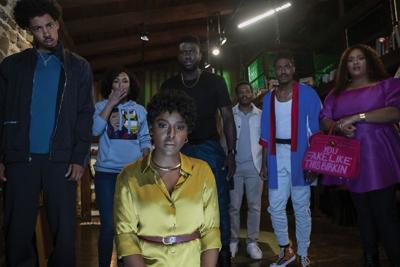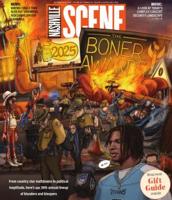Director Tim Story (Barbershop, India.Arie’s “Brown Skin” video, Shaft 2019) is breaking some new ground with his latest film, a horror-comedy that draws equally from Jordan Peele and the Keenen Ivory Wayans-era Scary Movies. While there have been horror films with predominantly Black casts before (Ax ’Em, Holla If I Kill You), The Blackening is getting a higher-profile release, and the time is absolutely right for it.
A friend group of Black people’s Juneteenth reunion at a luxe cabin in the woods with murder on the menu is absolutely something that mainstream exhibitors typically ignore, so for whatever reason, let’s hear it for some awareness. Below is a discussion between two of our contributors about The Blackening and its impact.
Jason Shawhan: When Diedrich Bader from Idiocracy and The Drew Carey Show turns up as Police Officer White, there’s a very specific tension that’s introduced that never fully gets defused, even through the very end of the film. Part of it is that he’s required to be whatever the story needs at several specific moments, but there’s that one scene where he talks about cookout theory and white presence, and I felt that like a ton of bricks. I’m honored that you asked me to be part of this discussion, and I promise to represent weirdo horror fans appropriately.
Sheronica Hayes: Ha! Officer White’s character is such an incredible translation of the complicated dichotomy between Black people and white allies. See, on the one hand, proximity to whiteness can provide safety and various other forms of privilege to people of color. But on the other hand, the omnipresent understanding that the switch can flip at any moment is so real. Black people know that our survivability is tethered to how palatable, submissive and overall desirable we are to the people in power. The symbolism of the friend group depending on Officer White, but side-eyeing him the entire time, was one of the most effective parts of the film for me!
JS: The titular game the friends play is incredibly striking because it’s never not upsetting to look at. It’s like the end credits for Bamboozled distilled into a single image.
SH: Ugh. It’s truly haunting. Literally any time a 3D face is protruding from a flat surface you know some fuckery is afoot. Between the Blackening game board and that cursed hand in A24’s Talk to Me (coming later this summer), I think we have two very strong horror-game contenders that can rival the Ouija board. It’s had a good run, but I think the culture really needs a change of scenery. Would you play the Blackening game if a friend broke it out at your next game night?
JS: That’s a very interesting question. I don’t think it would be appropriate, though it does feel like something that in theory could pop up at a game night. But would the game even appear in a situation that wasn’t in an all-Black space? Is it another example of the film’s complicated perspective on cookout theory? But as far as pandimensional or supernatural game shenanigans, I wouldn’t hesitate to play Jumanji, Zathura or Beyond the Gates.
SH: You’re right. The genesis of the game is about feeling ostracized in the Black community, so outside of the pure trivial elements of it, there would be no reason for the game to appear outside of a Black space.
JS: One of the film’s foundation points is how for so long, Black characters were often the first to die in horror films. And that immediately got me thinking about whether that is the case anymore. Looking at a lot of late ’70s through early ’90s horror, that feels like something that did happen — often enough to stick in the minds of socially conscious viewers. If anything, I think horror cinema has become aware enough of that trope to use it to play against the expectations of the audience — horror loves to evolve, often more quickly than mainstream society.
SH: It would be a disservice to not acknowledge that the “Black Guy Dies First” trope isn’t rooted in any sound reality. Intellectually, I know how this false phenomenon became a cultural truth, and it has to do with representation. Sure, sometimes the Black person dies first in horror movies, but more often than not, they don’t. More accurately, there is typically only one tokenized Black person in popular horror films, and when that character dies, as most characters inevitably do in the genre, their deaths are more impactful on the audience. So even if the trope isn’t objectively true, the sentiment is what’s important, and I believe that it did inspire horror filmmakers to reconcile with the fact that we are sick of seeing only white people survive. This has led to more diverse casting, increasing the odds of at least one person of color being alive when the end credits roll. It’s always been about who gets to live and who doesn’t, but that doesn’t have the same je ne sais quoi as “the Black guy dies first,” does it?
JS: One of the most fascinating things to me about The Blackening is how useful it is at teaching and illustrating intersectionality. As much as Hollywood likes to portray minorities as monoliths, even though all of the main characters are Black, there’s a lot more going on. Allison is multiracial, Dewayne is gay, Shanika is a BBW, Clifton is … well, Clifton. But when all your characters are Black, even the most blindered viewer has to expand their perceptions.
SH: I’m so thankful you bring this up, because it directly ties into what I expressed earlier about representation. When there’s one token Black person in a film, of course they are monolithic. Quite literally. That character has to somehow become the mascot of an entire race of people, which we know is impossible. Especially when it’s a character of color born in the mind of a white man with a toe fetish or something. The beauty of horror movies like The Blackening is that we get to see identities across the spectrum of Blackness. Fully fleshed-out individuals with unique personalities. Imagine you went to a symphony and it was nothing but 100 guys playing the tuba. That’s what the movie industry tries to do with Black characters in cinema. But like a symphony, there has to be diversity within any body of art that works harmoniously with all of the different variables to create a finished product that’s complex, beautiful and full of depth.
JS: Shanika (played by Emmy nominee X Mayo) is my favorite character, both because she’s a great personality but also she’s a plus-size woman who can still handle business. Her weight is simply an aspect of who she is, and she’s an inspiration to my big ass just by being her.
SH: Our weight is simply an aspect of who any of us are, but for some reason, when it comes to Black women, Hollywood decided that weight was a personality type. Shanika is lovable because she’s fashionable as hell and down to earth while maintaining a great sense of humor, and you can tell that she has so much love for her friends. As a chunky gworl, I definitely find myself endeared to characters who have a body type similar to mine, but I know that if more women with average bodies were represented in media, we wouldn’t project on the ones who do make it so much.
JS: The question I keep asking myself after the film is, “Are Android phones racist?” I’m still pondering that. The internet, as you know, is kinda inconclusive. But it feels like this is a case of the film addressing some things that society hasn’t?
SH: Ya know, that is the million-dollar question. I think Androids get a bad rep because they don’t foster the same sense of interconnectedness that iPhones do. Androids prove to have superior processing systems and cameras than iPhones year after year, but by God, the people want emojis and to see an ellipsis when someone is typing. Android has just never been able to achieve the cult-like reception that iPhones have, and part of that is lackluster branding. And what is racism, if not refusing to adopt ideas that make people feel like their wants and needs are being met?
JS: There are times when I watch queer-themed films, and things get a bit too real, and I find myself filing those works in a folder of art that I call “Not in Front of the Straight People.” Sometimes, there’s business that’s not for just anyone to see. And there are moments in The Blackening when I thought I might be trespassing a bit. I mean, a wide theatrical release is in theory meant for anybody and everybody. But do you feel that the film was telling too much?
SH: Oof. I’ve been spending so much of my adult life combating respectability politics. I could write volumes about it, and how it shows up in media. I think it’s beautiful how contemporary cinema destigmatizes a lot of behaviors and narratives that have felt taboo for decades. However, I do think there are some cultural novelties that feel very sacred, and I totally understand wanting to keep them protected from the grubby hands of culture vultures. The Blackening is full of moments that I never thought I would witness in a mainstream horror film, such as a nod to dark-skinned Aunt Viv and that brilliant sequence where everyone shamefully knows too much about the show Friends. I guess ultimately where I land is: There’s way more value in sharing art that makes people feel more connected with their community than gatekeeping for fear that the sanctity of it will be ruined.





